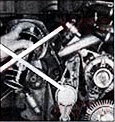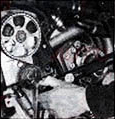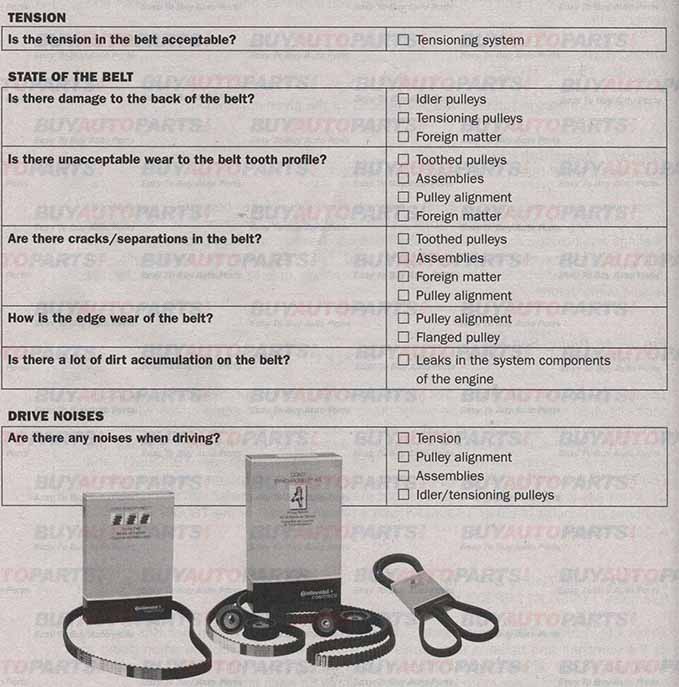What is a timing belt?
The timing belt, a part of the internal combustion engine, connects the camshaft and crankshaft. It ensures that the engine's valves close and open at the right time during the intake and exhaust strokes. It prevents a collision between the engine's piston and valves. A timing belt is also used to run other engine components such as the oil pump and water pump.
How to Change a Timing Belt Properly:
Here are some points to remember when changing your belts to ensure the drive functions properly.
Tip 1:
a) When installing belts, only use the correct tool. The belt must be placed in position manually. In no circumstances should timing belts be forced, e.g. with rim levers, onto toothed pulleys or rolled over flanged pulleys. Such action would damage the tension member.

Tip 2:
a) Never allow caustic or corrosive liquids to come into contact with the belt drive, as they could damage the plastic parts.
b) Keep the belt well away from oil mist, dripping oil, and other chemicals.
c) Always comply with the installation instructions of the vehicle manufacturer. These are printed in the owner's manual in the section explaining how to change a timing belt.
d) Never allow caustic or corrosive liquids to come into contact with the belt drive, as they could damage the plastic parts.
e) Regardless of which components are defective – whether tensioning pulley, idler pulley, or guide pulley - all these components must be replaced.

Changing a Timing Belt:
Step 1:
a) Disconnect the earth cable from the battery.
b) Remove all drive belts, pulleys, or hoses that could get in the way when the timing belt is removed.
c) Remove the timing belt cover.
d) Turn the crankshaft in the running direction of the engine as far as top dead center, and bring the marking on the engine case into line with the marking on the crankshaft vibration damper and the camshaft.

Step 2:
a) Loosen the adjusting screw of the tensioning pulley.
b) Pull the tensioning pulley away from the timing belt and screw the tensioning pulley tight again.

Step 3:
a) Remove the timing belt.
b) Check tensioner, smooth back idler pulleys and belt pulleys for wear or damage. If necessary, replace them.

Step 4:
a) Adjust all markings until they are properly aligned.
b) Place the new timing belt on the pulleys.
c) Loosen the adjusting screw of the tensioning pulley, allowing the pulley to move freely.
d) Turn the adjusting screw carefully into its final position (make proper allowance for the spring pressure). If the tensioning pulley is not automatic, tension the timing belt as specified by the vehicle manufacturer, using the tensioning device provided for this.

Step 5:
a) Check the alignment of the markings.
b) Rotate the crankshaft by at least two complete revolutions in the running direction of the engine to ensure the timing belt is properly tensioned by the tensioning pulley.
c) Check the alignment of the markings once again.
d) Put the tensioning pulley in its intended position and tighten the screws with the specified torque setting.
e) Refit the timing belt cover as well as all drive belts, pulleys, and hoses that were removed.
f) Reconnect the earth cable to the battery and start the engine.
g) Make any adjustments that are necessary.
h) Dispose of the replaced belt in an environmentally friendly way.

WHAT IS THE INTERVAL FOR CHANGING THE TIMING BELT?
The change intervals stipulated for timing belts vary depending on the vehicle manufacturer. They can range from 25,000 to 75,000 miles depending on make and model. Always consult the vehicles' service manual for recommended change interval. Early detection saves many problems. Answering the following questions will help you determine if the timing belt needs to be replaced.

Find the Right Timing Belt for your Vehicle here!
Check out Buy Auto Parts' extensive range of timing belts that carry an industry-leading warranty at unbeatable prices! To place an order, just select the right year, make and model of your vehicle. You can get your timing belts delivered from the warehouse closest to your location at the earliest. Buy Auto Parts sells thoroughly-tested OEM replacement and aftermarket parts for every car make and model. We offer free shipping for orders over $99 in the continental United States. You can convey your difficulties to us through our toll-free number, or you can leave us an email at [email protected]. We have got automotive professionals to answer to your queries regarding any of our parts.


